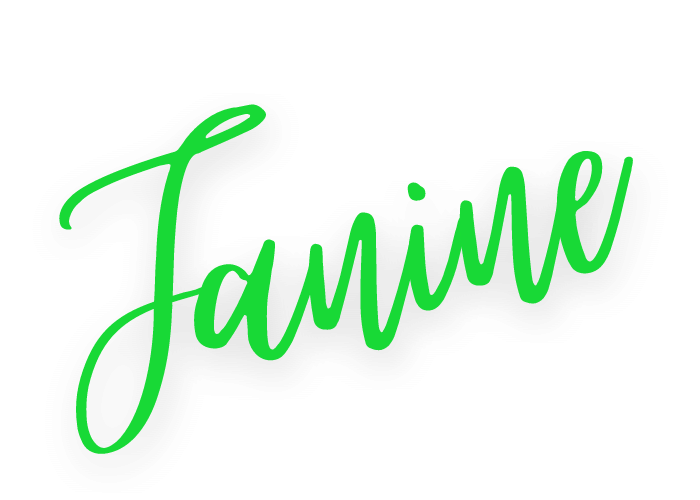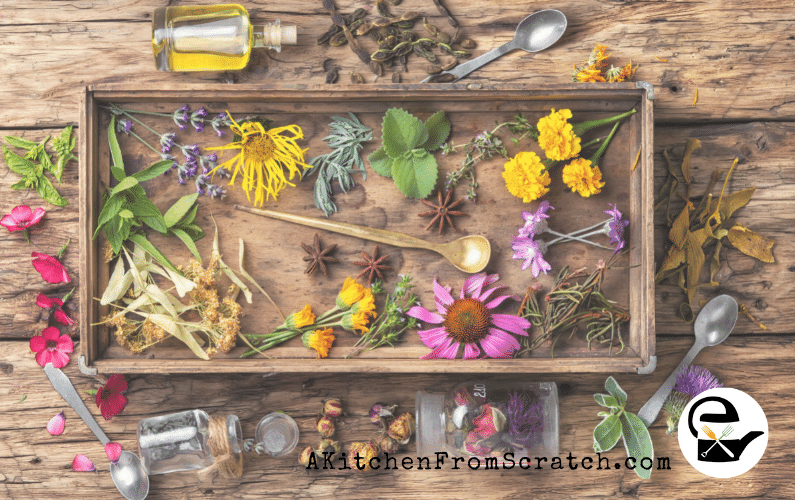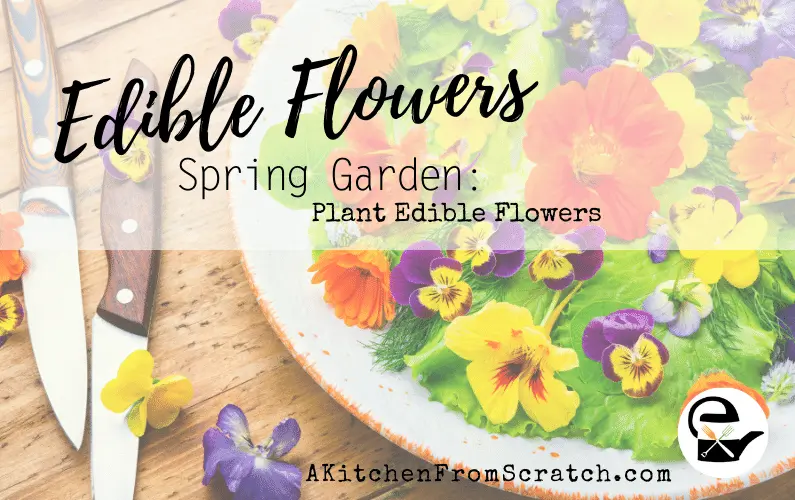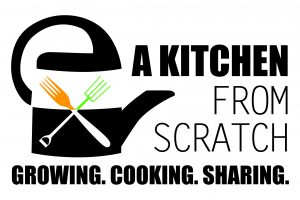Have you ever seen a flower and thought, ‘that looks good enough to eat? Well, you’re in luck! There are many options for growing and eating flowers – and we aren’t talking just herbs!
Natural, beautiful, vibrant, delicious flowers can bring your salads and baked goods to life!
Edible flowers make a great addition to the garden; they look great, smell fantastic, and have tremendous flavors. YUM!PRO TIP: When growing edible flowers, avoid all fertilizers and chemical pesticides so that there is nothing but the natural flavor. Always label your edible flowers, and if in doubt – don’t eat them!
How do I start an edible garden?
Here are some tips to get you started planting your edible garden.
Start small
No matter how much space you have, it is important to plan where and what you will plant. You might be surprised just how much will come to fruition at once.
Start by incorporating them into your vegetable or herb garden.
Find some large pots or an area in your garden that you will use for your edible flowers. After the first year, add a few more – so you don’t get overwhelmed.
Plan
How much time do you have to tend your garden? How many edible plants do you want? What will you use them for? Decide all of this and then plan what you will plant and when.
Soil
Compost-rich soil is a must for your edible flowers – because you want to have them infused with nutrients. Research how to create your soil and what types of soils (and additives) edible flowers need to grow well. Or Make your own compost.
Weed
Weed often and weed ruthlessly – once a week, head into your garden and pluck out anything that isn’t what you have planted. After all, weeds is just anything you don’t want in your garden space.
Are there benefits to planting edible flowers?
Biodiversity in the garden is a big deal, alongside your fruits, veggies, flowers, and herbs – edible flowers make sense! Edible flowers add texture and colors and entice plenty of pollinators too. They are also great natural pest deterrents and companion plants.
Are there benefits to eating edible flowers?
For years, herbs and flowers have been used in medicines and spiritual and well-being practices. It’s not surprising to know that humans have an affinity with nature and that what grows naturally and is planted is good for us.
Here are some health benefits for edible flowers you can grow at home!
Marjoram
Marjoram tea is a natural remedy for helping tummy troubles; the antioxidants and chemicals within marjoram have anti-inflammatory and gastroprotective effects. Both the flowers and the marjoram plant are edible.
PRO TIP: I love to marjoram it to my vegetables before roasting to give it a natural buttery flavor.
Marigold
Marigolds are beautifully bright orange edible flowers used for tinctures, ointments, and herbal teas. Not only that, but marigold flowers have soothing properties and can help with warts, dry skin, bites, and even sunburn!
Marigold tea is high in antioxidants and has anti-inflammatory properties. Studies show that its constituents also have antiseptic qualities and can be used as a natural antibiotic when applied to sick regions. Wow!
Marigolds tastes depend on the soils but are usually grown with tomatoes so they have a sweet acidic flavor.
They are most commonly known to keep pests away from tomato plants. Add the edible kind of Marigolds to your salad, pesto, or garnish to any meal.
Calendula
The edible flower calendula has been used for generations in cooking and as an adornment. It is a plant that fights viruses and has anti-inflammatory properties thanks to its potent flavonoids. It’s good for you.
According to studies, the antioxidants in calendula shield the body from pro-inflammatory substances, including cytokines and free radical damage.
Additionally, the edible bloom contains linoleic acid, a potent anti-inflammatory. Makes a great tea, tincture, or addition to your favorite salad.
Nasturtium
Nasturtium is heavily featured in South African medicinal practices. Nasturtium comes in yellows, reds, and oranges – reminiscent of sunsets. It’s all edible too! Packed with vitamins C, A, and lutein.
Nasturtium extracts are prized for their ability to fight bacteria and have inherent antibiotic qualities. They offer a peppery flavor perfect for pesto and salads.
Great pest deterrent in any garden space. be warned that nasturtiums can get out of control. Make sure to prune as needed.
Chrysanthemum
This one might come as a surprise! Most people don’t know that you can consume chrysanthemums! It is used in traditional (folk) medicine to treat bone diseases, sleeplessness, and headaches.
These flowers are abundant in Anthocyanins, potent antioxidants to support anti-inflammatory pathways.

It is also used in Chinese medicine to help promote sleep and relaxation – most often drunk in a delicious tea.
Hibiscus
Hibiscus tea has been a staple tea for years and gives a beautifully rich color liquid. The dried flower parts, especially the calyx, the flower’s covering, are used to make traditional hibiscus tea.
Hibiscus is used to support normal levels of cholesterol and blood pressure. Because of the anthocyanins and polysaccharides found in this flower, it also functions as an antioxidant.
Violets
Violets offer a sweet and floral flavor that is quite special. Sugared violets are delicious and will last all year long. Violets grow well in a shady and moist environment and either the garden or pots. Try violets in a salad.

Add violets to your bathwater for one of the most relaxing baths you’ll ever have – to increase the joy, add some dandelions.
Violet is said to have inflammation-reducing properties; it can soothe skin irritations and help with swelling. It is also said that violets are good for colds and coughs when mixed with honey for cough syrup.
Are there herbs that have some edible flowers?
Many of us stick to using just the green leaves of the herbs we plant, but many herbs offer some flavorful flowers too! Don’t toss these out. They are the best part of the herb.
You can get edible flowers from the following herbs:
- Hyssop
- Basil
- Chives
- Dill
- Garlic
- Fennel
- Anise
- Cilantro
- Thyme
- Borage
PRO TIP: Garlic, Chives and onions also grow a flower called a scape. What can you do with scapes?
Where are the best ways to add edible flowers?
Once you have a selection of edible flowers ready for plucking, you’ll be chomping at the bit to get them in all of your recipes.
Flowers are beautifully used as a garnish on dishes, in addition to your favorite salads, or blended in pesto.
Edible flowers compliment many types of meats and make a plain white iced cake something special!
Herbed butter is also so beautiful with flowers. Look at these herbed butter recipes.
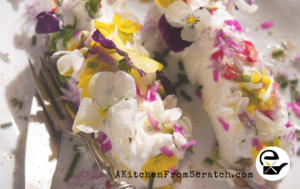
Aside from all the beautiful ways they can be used in food, they make a tea that will leave you feeling rested and rejuvenated in no time.
Additionally, they can be added to a bath or mixed in soaps and tinctures.
Is eating flowers a spiritual thing?
There is a significant connection between eating things grown from the earth and spirituality. People looking for peace, calm, and a more substantial connection to the world around us will often aim to have more natural, earthy additions to their diet – including edible flowers.
PRO TIP: Eating flowers can give you a sense of well-being and calm that a regular caffeine-packed tea won’t!
Bring beauty, flavor, and a deeper connection to nature by growing and enjoying your edible flowers.
The possibilities are endless.
Want to know what to eat, what to plant and when? Begin your Kitchen GARDEN From Scratch with a Consultation.
